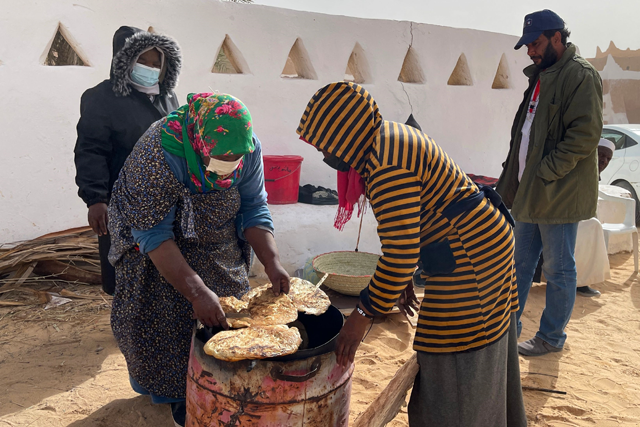You are here
Middle East, North Africa hot spots tout for tourists
By Reuters - Mar 08,2014 - Last updated at Mar 08,2014
BERLIN — Fancy a holiday in Yemen? What about Libya? Iraq, perhaps?
It’s a tough sell, but tour operators from locations considered among the world’s most dangerous have been trying to drum up interest at the world’s biggest travel fair, the ITB Berlin in the German capital.
Their brochures offer tantalising views of exotic souks, ancient ruins and breathtaking natural scenery, but curious visitors usually end up asking about the latest footage of violence and unrest they’ve seen on the television news.
“OK, you cannot visit all places in Yemen,” conceded Ibrahim Mohammed Al Attab, deputy marketing manager of the Yemen Tourism Promotion Board. Tourists were generally not at risk in cities, but Westerners should avoid crowds, he advised.
Attab, like his counterparts from Iraq and Libya, tried to stress the cultural and natural attractions of his country, ravaged by conflicts in the past half century and well off the beaten track for most travellers.
“But you can visit the city of Sanaa, Socotra Island and the famous ‘skyscraper city’ Shibam, so the most important sites in Yemen are secure,” he said, referring to the 16th century mudbrick towers of Shibam.
Among Yemen’s visitors are nature buffs and scientists who go to Socotra Island, home to unique plants and birds, and archaeologists interested in sites like Sanaa’s Old City, tourist board marketing officer Ahmed Y.Al Washali said.
Most come from China, Taiwan, Japan and South Korea: “Those governments don’t give such a high alert.”
He said about a million tourists visited Yemen in 2013, including Arabs from nearby states.
At Yemen’s stand, tour operators seated under photos of rugged mountains, exotic trees and a deserted beach handed out brochures showcasing their country’s cultural heritage.
Travel advice from countries like Britain and the United States warning citizens to avoid Yemen because of the risk of terrorism has hurt business, said Attab. Yemen should persuade such governments to change their advice, he added.
The impoverished Arabian Peninsula state is battling southern separatists, Al Qaeda-linked militants and rebels from the Houthi movement.
“We have to change the negative image to a really positive image of Arab generosity and hospitality,” Attab said.
Libyan ‘daydream’
Libya hopes photos of camels and Roman ruins will persuade visitors to forget about the lawlessness still gripping much of the country three years after Muammar Qadhafi was toppled.
One brochure promoted Libya as a “daydream” of desert lakes surrounded by lush greenery and crystal-clear seawater lapping isolated, palm-fringed beaches. But officials acknowledged visitors were still put off by conflict between the militias who helped to overthrow Qadhafi and his allies.
“The number of tourists coming plummeted after the revolution as the security situation wasn’t clear and the government didn’t give out permits for tourists to visit because it wasn’t sure if they’d come back,” said Abdussamea Almahbob, undersecretary for tourism, through an interpreter.
“Now it’s trying to make everything better,” he said.
Britain and the United States advise against travel to Libya. A Briton and a New Zealander were killed in an execution-style shooting on a beach near Sabratha in January.
Most visitors to Libya are archaeologists drawn by the Roman ruins or adventurers who take tours of sand dunes.
Abdurrazag Guerwash, head of Winzrik Group which offers tours to Tripoli and the oasis town of Ghadames, said the eastern city of Benghazi and southern Libya remained “very dangerous” but some pockets of the country were safe for holidays.
“Leptis Magna, Sabratha and Ghadames are very safe, very nice and very controlled areas and there’s a lot of things to see,” he said, adding most clients were Spaniards or Italians.
In 2013, he took 400 people on tours compared with up to 6,000 per month before the war. “We hope it gets better next year,” he said.
Iraqi shrines
Iraqi travel firms and hotels were also seeking business with posters of Islamic shrines and marsh landscapes.
While insisting the north of the country was safe for tourists, they found it hard to change people’s image of a country where nearly 8,000 civilians were killed in political violence in 2013.
The United States warns against all but essential travel. Britain makes an exception for the Kurdistan region in the north.
“It’s difficult to persuade people to go as there is still a war going on — a civil war,” said Lora El Jamal from the Iraqi travel firm Raihana Universal. “People are a bit scared even though they’d like to go when they see the brochures.”
Iraq is home to some of the holiest sites in Shiite Islam, such as the Imam Ali Mosque in Najaf and the Imam Hussein shrine in Kerbala and other sites around the country. Many mosques, both Shiite and Sunni, have been bombed in recent years.
Much of the demand to visit Iraq comes from Muslims going on pilgrimages.
Related Articles
GHADAMES, Libya — Young girls in colourful dress and traditional jewellery sing at a festival in Libya’s Ghadames, an oasis city that was re
SOCOTRA, Yemen — Only goats seeking shade now use the long-abandoned lines of Soviet-era T-34 tanks, but the rusting relics point to the str
AMMAN — A memorandum of understanding that was signed by the Jordanian and Iraqi governments outlining cooperation in the tourism sector was













